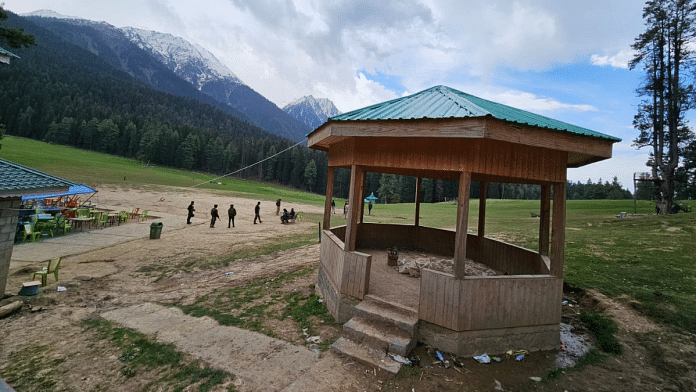Thank you dear subscribers, we are overwhelmed with your response.
Your Turn is a unique section from ThePrint featuring points of view from its subscribers. If you are a subscriber, have a point of view, please send it to us. If not, do subscribe here: https://theprint.in/subscribe/
On the surface, this looked like a macabre episode in the India–Pakistan feud. But if you look closer, the lines blur. The terrorists had singled out and killed only Hindu males. Pahalgam has eerie parallels with Gaza. In both cases, symbols of religious grievance, weaponized by ideological networks, masquerade under the guise of local struggles.
Pahalgam is a peaceful haven for visitors. But on that fateful day, gunmen opened fire, shattering a belief that Kashmir may be inching toward normalcy and development. The infrastructure investment in Kashmir and the booming tourism industry were evident. A local party opposed to the ruling BJP at the centre won a peaceful election. The state was healing from decades of mistrust and insurgency. The fact that the Kashmiri common man carried out public rallies condemning the killings bears testimony to their agony at the status quo ante being splintered overnight.
It was in Pakistan’s interests to destabilise the state government, destroy tourism and divide the populace.
The attack was horrifying. But it wasn’t random.
Just weeks earlier, Pakistan’s Army Chief General Asim Munir—a madrassa-educated Hafiz-e-Quran and former ISI chief—delivered a chilling speech invoking jihad, naming Kashmir as Pakistan’s “jugular vein.” He demeaned Hindus and scoffed at the idea of Hindus and Muslims living harmoniously.
Days later, civilians were massacred. The connection isn’t coincidental. The attack was orchestrated by Lashkar-e-Taiba, under ISI’s protection.
This mirrored Gaza-and the modus operandi of Hamas and Hezbollah: attack, escalate and pre-empt blame by hiding behind officialdom.
Across the world, Gaza is viewed as more than a place. It’s a metaphor for Muslim victimhood, resistance, and grievance. It invokes protests from Istanbul to Islamabad, from Columbia University to JNU.
And it’s not just grief that travels—it’s ideology.
Like Gaza, Kashmir is another a rallying point in a transnational narrative: Muslims under siege, Islamic lands occupied, innocents massacred. From ISIS to Hamas, these narratives feed on conflicts.
Gaza and Kashmir are showpieces for these forces. They see civilians as lambs to be sacrificed. Terrorism is cloaked in the language of divine duty—a perverse moral license granted by blind faith.
This ideological alignment isn’t accidental.
Turkey under Erdoğan emerged as a supporter of both Palestinian and Kashmiri “liberation.” He pushes for pan-Islamic solidarity, brushing aside Hamas atrocities on one side while amplifying military crackdowns on the other. Pakistan does the same—flaunting its role as a global defender of Muslims, supporting groups like Jaish-e-Mohammed and Lashkar-e-Taiba.
Elsewhere, Qatar’s Al Jazeera wraps both Gaza and Kashmir with the same cloth. Malaysia under Mahathir, frequently linked the two in speeches. Even Saudi Arabia, until recently, had spent decades exporting Wahhabi ideology that fuelled militant groups.
Pakistan’s role is not ambiguous. Its military-intelligence apparatus has long used Kashmir the way Iran uses Gaza: as a controlled switch.
Just as Iran bankrolls Hamas while posing as a peace-seeker, Pakistan trains and harbours terrorists as it presents itself as a diplomatic actor. Their aim is not peace, but orchestrated chaos—justified by fanatical devotion and subjugation to divine will.
Munir personifies this doctrine – a poisonous concoction of military command and Islamist conviction. His speeches blur Quranic commandment with strategic posturing. And the attacks that follow are rarely spontaneous.
The same logic guides Hamas: wrap military aggression in the language of holy resistance -provoke retaliation-leverage the fallout to radicalize the next generation.
Kashmir and Gaza are fuel for a global story that brainwashes young men into martyrdom. A story that feeds on grievance and victimhood.
In this story, there’s no room for nuance, subtlety or variation. No lines are drawn between an innocent civilian and a ferocious combatant. No vision for peace—only mindless, endless holy war.
The victims in Pahalgam are part of this loop. Just as the victims in the Israeli kibbutzim. Their suffering becomes fodder and their deaths, divine victories.
Kashmir is no longer just a border dispute. It is part of an ideological axis that links South Asia with the Middle East. It is a node in a molecular configuration that thrives on manufactured martyrdom.
India is not at war with Pakistan’s people, just as Israel is not at war with Gaza’s civilians. Both are at war with an idea—one that spreads across borders, weaponizes faith, and sustains itself through horror and spectacle.
Peace demands more than the silencing of guns—it demands the dismantling of a narrative that sanctifies bloodshed. One that binds Gaza to Kashmir not by shared pain, but by the cold calculus of exploitation—where suffering is weaponized, and martyrdom is manufactured. A return to the previous situation will inescapably mean the nurturing and spread of terrorist activities throughout India.
These pieces are being published as they have been received – they have not been edited/fact-checked by ThePrint.


